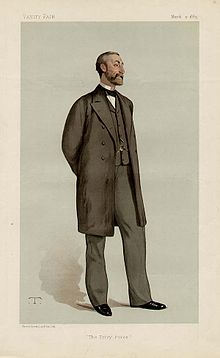Henry Ponsonby
This article needs additional citations for verification. (October 2008) |
Sir Henry Ponsonby | |
|---|---|
 | |
| Private Secretary to the Sovereign | |
| In office 1870–1895 | |
| Monarch | Queen Victoria |
| Preceded by | Sir Charles Grey |
| Succeeded by | Sir Arthur Bigge |
| Personal details | |
| Born | Henry Frederick Ponsonby 10 December 1825 |
| Died | 21 November 1895 (aged 69) |
| Nationality | British |
| Spouse | Mary Elizabeth Bulteel |
| Children | 5, including Frederick and Arthur |
| Parent(s) | Sir Frederick Cavendish Ponsonby Lady Emily Charlotte Bathurst |
Major-General Sir Henry Frederick Ponsonby GCB PC (10 December 1825 – 21 November 1895) was a British soldier and royal court official who served as Queen Victoria's Private Secretary.
Biography
Born in Corfu, he was the son of Major-General Sir Frederick Cavendish Ponsonby, an Anglo-Irish nobleman who was a senior commander in the British Army.
He entered the army on 27 December 1842 as an ensign in the 49th Regiment of Foot. Transferred to the Grenadier Guards, he became a lieutenant on 16 February 1844, captain on 18 July 1848, and major on 19 October 1849. From 1847 to 1858 he was aide-de-camp to Lord Clarendon and Lord St. Germans, successively lord-lieutenants of Ireland. He served through the Crimean campaigns of 1855–1856, becoming lieutenant-colonel on 31 Aug. 1855; for the action before Sebastopol he received a medal with clasp, the Turkish medal, and the Order of the Medjidie, 3rd Class. After the peace he was appointed equerry to Albert, Prince Consort, who greatly valued his services. On 2 August 1860 he became colonel, and in 1862, after the death of the prince, he was sent to Canada in command of a battalion of the Grenadier Guards which was stationed in the colony during the American Civil War. On 6 March 1868 he became a major-general.
Ponsonby embellished letters to his children at Eton with a series of illustrations in which he concealed the school's address. It was a family quirk continued by his son, Arthur Ponsonby, and recently revived by descendant Harriet Russell. His letters bore addresses appearing as doodled signposts in snowstorms or as huge envelopes shouldered by tiny people.[1]
He served as Keeper of the Privy Purse and Private Secretary to Queen Victoria. His appointment occurred on 8 April 1870, after the death of prior Private Secretary General Sir Charles Grey, who was "a son of Earl Grey, the Prime Minister" at the time and who was wife Mary Ponsonby's "Uncle Charles."[2] Both Arthur and Mary Ponsonby contributed pseudonymously to magazines and newspapers of the day.[3]
On 6 January 1895 he was attacked by paralysis; in May he retired from his offices, and on 21 November he died at East Cowes on the Isle of Wight. He was buried at Whippingham.
Family

On 30 April 1861, Ponsonby married Hon. Mary Elizabeth Bulteel, Maid of Honour to Queen Victoria and a daughter of John Crocker Bulteel (1793–1843) MP. The couple had six children:[4]
- Alberta Victoria Ponsonby (6 May 1862 – 15 October 1945)
- Cecil William Davidge Ponsonby (28 March 1863 – 16 January 1936)
- Magdalen Ponsonby (24 June 1864 – 1 July 1934)
- John Ponsonby (25 March 1866 – 26 March 1952)
- Frederick Edward Grey Ponsonby (16 September 1867 – 20 October 1935)
- Arthur Augustus William Harry Ponsonby (16 February 1871 – 24 March 1946)
Lady Caroline Lamb (née Ponsonby), his father's sister, had been married to Lord Melbourne, a crucial advisor to Queen Victoria during her first years on the throne.
Legacy
His son Arthur wrote a biography of him which won the James Tait Black Memorial Prize in 1942: Henry Ponsonby, Queen Victoria's Private Secretary: His Life from His Letters.
In Mrs. Brown, he was portrayed by Geoffrey Palmer whose close friend and frequent co-star, Dame Judi Dench, played Queen Victoria. In the movie Victoria & Abdul, he was portrayed by Tim Pigott-Smith.[5]
References
- ^ "Return to sender: Artist puts Royal Mail to the test". The Independent. 8 October 2008. Retrieved 24 August 2017.
- ^ Arthur Ponsonby. Henry Ponsonby, Queen Victoria's Private Secretary: His Life from His Letters (London: Macmillan, 1943), pp. 35–36.
- ^ Ponsonby, p. 37.
- ^ Lodge 1867, p. 62.
- ^ "Victoria & Abdul vs the True Story of Abdul Karim and Queen Victoria". HistoryvsHollywood.com.
Bibliography
- Lodge, Edmund (1867). The Peerage and Baronetage of the British Empire as at Present Existing. Hurst and Blackett.
{{cite book}}: Invalid|ref=harv(help)  This article incorporates text from a publication now in the public domain: "Ponsonby, Frederic Cavendish". Dictionary of National Biography. London: Smith, Elder & Co. 1885–1900.
This article incorporates text from a publication now in the public domain: "Ponsonby, Frederic Cavendish". Dictionary of National Biography. London: Smith, Elder & Co. 1885–1900.
- Use dmy dates from April 2012
- 1825 births
- 1895 deaths
- Ponsonby family
- Knights Grand Cross of the Order of the Bath
- British Army personnel of the Crimean War
- Grenadier Guards officers
- Private Secretaries to the Sovereign
- People from Corfu
- Members of the Privy Council of the United Kingdom
- British Army generals
